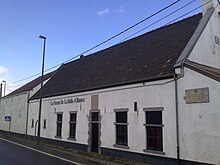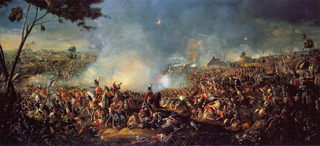
The Battle of Waterloo was fought on Sunday 18 June 1815, near Waterloo, marking the end of the Napoleonic Wars. A French army under the command of Napoleon was defeated by two armies of the Seventh Coalition. One of these was a British-led force with units from the United Kingdom, the Netherlands, Hanover, Brunswick, and Nassau, under the command of the Duke of Wellington. The other comprised three corps of the Prussian army under Field Marshal Blücher; a fourth corps of this army fought at the Battle of Wavre on the same day. The battle was known contemporarily as the Battle of Mont Saint-Jean in France and La Belle Alliance in Prussia.

The Battle of Ligny, in which French troops of the Armée du Nord under the command of Napoleon I defeated part of a Prussian army under Field Marshal Blücher, was fought on 16 June 1815 near Ligny in what is now Belgium. The result was a tactical victory for the French, but the bulk of the Prussian army survived the battle in good order, was reinforced by Prussian troops who had not fought at Ligny, and played a role two days later at the Battle of Waterloo. The Battle of Ligny was the last victory in Napoleon's military career.
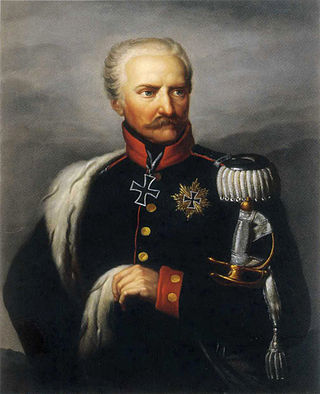
Gebhard Leberecht von Blücher, Graf (count), later elevated to Fürst von Wahlstatt, was a Prussian Generalfeldmarschall. He earned his greatest recognition after leading his army against Napoleon I at the Battle of the Nations at Leipzig in 1813 and the Battle of Waterloo in 1815.

The Hundred Days, also known as the War of the Seventh Coalition, marked the period between Napoleon's return from eleven months of exile on the island of Elba to Paris on 20 March 1815 and the second restoration of King Louis XVIII on 8 July 1815. This period saw the War of the Seventh Coalition, and includes the Waterloo Campaign and the Neapolitan War as well as several other minor campaigns. The phrase les Cent Jours was first used by the prefect of Paris, Gaspard, comte de Chabrol, in his speech welcoming the king back to Paris on 8 July.

La Haye Sainte is a walled farmhouse compound at the foot of an escarpment near Waterloo, Belgium, on the N5 road connecting Brussels and Charleroi. It has changed very little since it played a crucial part in the Battle of Waterloo on 18 June 1815.

Daniel Maclise was an Irish history painter, literary and portrait painter, and illustrator, who worked for most of his life in London, England.

The Battle of Quatre Bras was fought on 16 June 1815, as a preliminary engagement to the decisive Battle of Waterloo that occurred two days later. The battle took place near the strategic crossroads of Quatre Bras and was contested between elements of the Duke of Wellington's Anglo-allied army and the left wing of Napoleon Bonaparte's French Armée du Nord under Marshal Michel Ney. The battle was a tactical victory for Wellington, but because Ney prevented him going to the aid of Blucher's Prussians who were fighting a larger French army under the command of Napoleon Bonaparte at Ligny it was a strategic victory for the French.

The Waterloo campaign was fought between the French Army of the North and two Seventh Coalition armies, an Anglo-allied army and a Prussian army. Initially the French army had been commanded by Napoleon Bonaparte, but he left for Paris after the French defeat at the Battle of Waterloo. Command then rested on Marshals Soult and Grouchy, who were in turn replaced by Marshal Davout, who took command at the request of the French Provisional Government. The Anglo-allied army was commanded by the Duke of Wellington and the Prussian army by Field Marshall Graf von Blücher.

The Lion's Mound is a large conical artificial hill in the municipality of Braine-l'Alleud, Walloon Brabant, Belgium. King William I of the Netherlands ordered its construction in 1820, and it was completed in 1826. It commemorates the spot on the battlefield of Waterloo where the king's elder son, Prince William of Orange, is presumed to have been wounded on 18 June 1815, as well as the Battle of Quatre Bras, which had been fought two days earlier.

The Battle of Issy was fought on the 2 and 3 July 1815 in and around the village of Issy, a short distance south west of Paris. The result was a victory for Prussian General von Zieten over a French army commanded by General Dominique Vandamme.
The Malplaquet proclamation was issued by Arthur Wellesley, 1st Duke of Wellington, commander of the Anglo-allied army on 22 June 1815. It announced to the French people that Wellington's army was there to restore their rightful king and government that had been usurped by Napoleon Bonaparte on his return from the island of Elba; and that their lives and their property rights would be honoured.

After the fighting at Quatre Bras the two opposing commanders Marshal Ney and the Duke of Wellington initially held their ground while they obtained information about what had happened at the larger Battle of Ligny. They received intelligence that the Prussian army under the command of Prince Blücher had been defeated by the French Army of the North under the command of Napoleon Bonaparte.

On 16 June 1815, the French defeated the Prussians at the Battle of Ligny. The Prussians successfully disengaged and withdrew north to Wavre where they regrouped, and later advanced westward with three corps to attack the right flank of the French army at the Battle of Waterloo. The French were slow to exploit Ligny; Napoleon wasted the morning of 17 June with a late breakfast and touring the previous day's battlefield before organising a pursuit of the two Coalition armies. Napoleon and Marshal Michel Ney took the French reserves to pursue the Duke of Wellington's Anglo-allied army. Marshal Emmanuel de Grouchy was ordered to pursue and harry the Prussians and prevent them from regrouping.
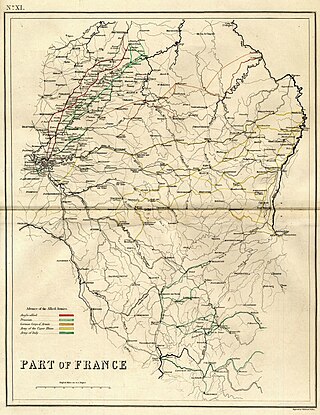
After their defeat at the Battle of Waterloo on 18 June 1815, the French Army of the North, under the command of Napoleon Bonaparte retreated in disarray back towards France. As agreed by the two Seventh Coalition commanders in chief, the Duke of Wellington, commander of the Anglo-allied army, and Prince Blücher, commander of the Prussian army, the French were to be closely pursued by units of the Prussian cavalry.
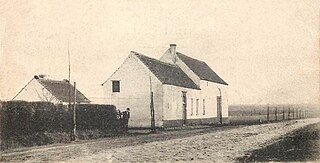
Decoster's house was a landmark location during the Battle of Waterloo. It stood on the eastern side of the Waterloo–Genappe main road south of the junction with the minor road to Plancenoit. According to Jean-Baptiste Decoster Napoleon spent the early part of the Battle of Waterloo and around Rossomme and then at about 17:00 moved to a position near Decoster's house where he remained until about 19:00.

Napoleon's Last HQ is a museum housed in the Ferme du Caillou at Genappe, Belgium, where the Emperor Napoleon stayed the night before the Battle of Waterloo on 18 June 1815. The site is located 4 kilometres (2.5 mi) south of the Lion of Waterloo, at Chaussée de Bruxelles 66, 1472 Genappe. Travelling north, the high road passes pass over the Waterloo battlefield through Waterloo and on to Brussels.
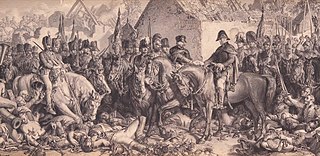
The Meeting of Wellington and Blücher after the Battle of Waterloo is a monumental wall painting by Irish painter Daniel Maclise, completed in 1861. It depicts the moment towards the end of the Battle of Waterloo on 18 June 1815, when the commanders of the allied British and Prussian armies, the Duke of Wellington and Marshal Blücher, met near La Belle Alliance. Measuring 3.68 by 13.92 metres, it is displayed in the Royal Gallery at the Palace of Westminster.

Arthur Wellesley, 1st Duke of Wellington, was an Anglo-Irish soldier and Tory statesman who was one of the leading military and political figures of 19th-century Britain, commanding the British Army during the Napoleonic Wars and serving twice as prime minister. He has frequently been depicted in various cultural media.
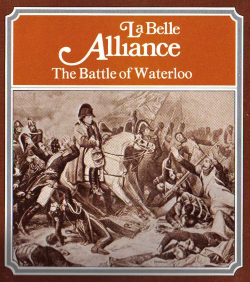
La Belle Alliance: The Battle of Waterloo is a board wargame published by Simulations Publications Inc. (SPI) in 1976 that simulates the Battle of Waterloo in 1815. It was one of four games that were published as part of the "quadrigame" titled Napoleon's Last Battles, but was also released as an individual "folio game", packaged in a shrinkwrapped cardboard folio.

